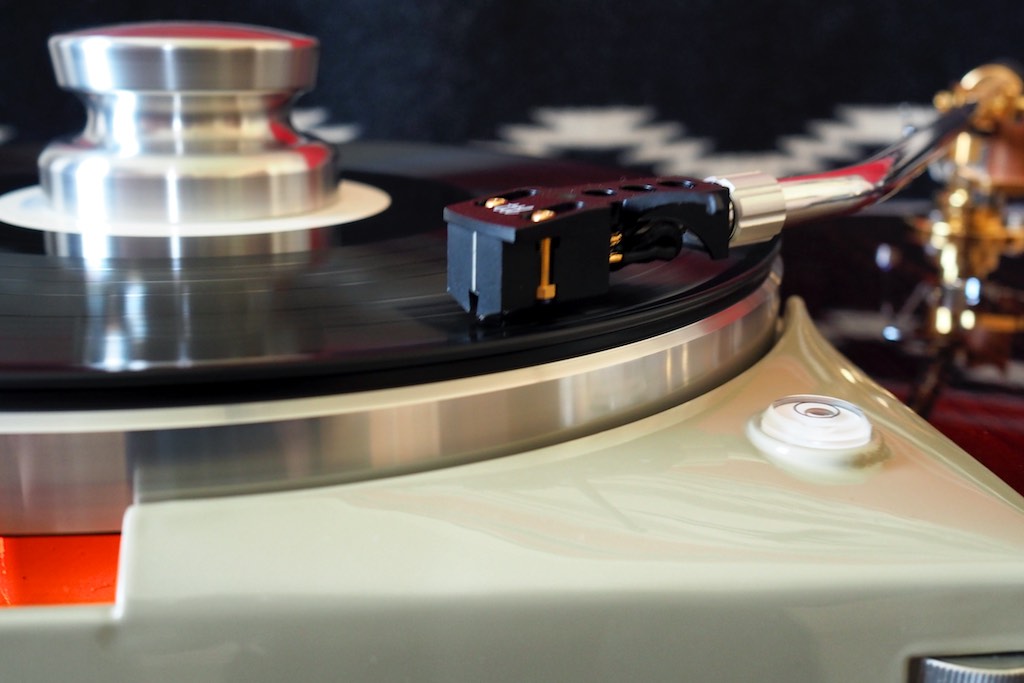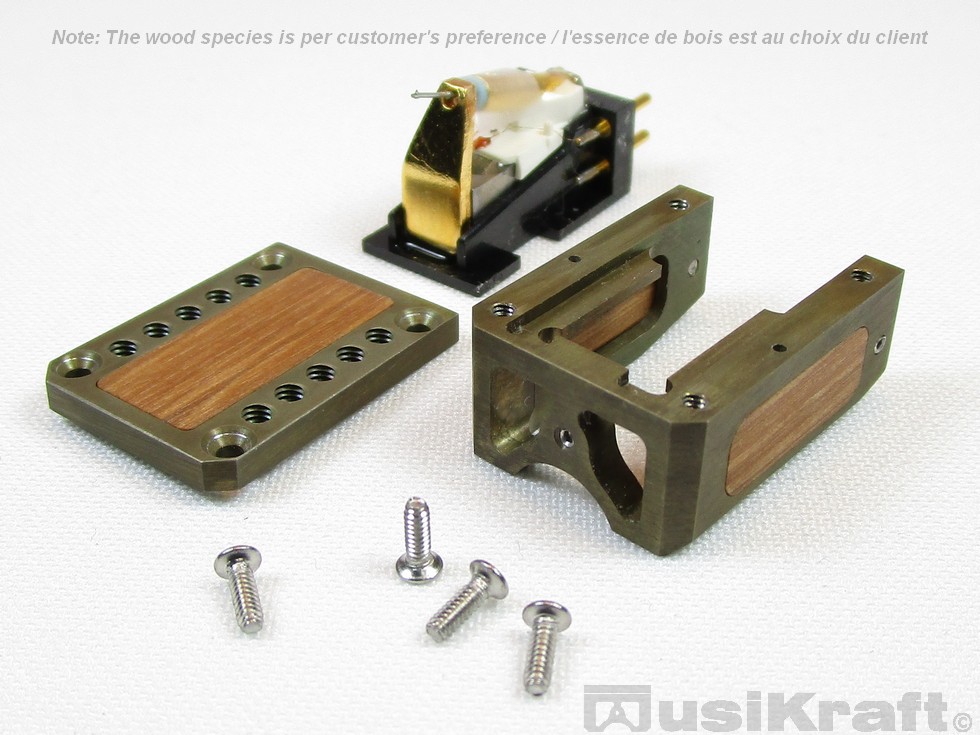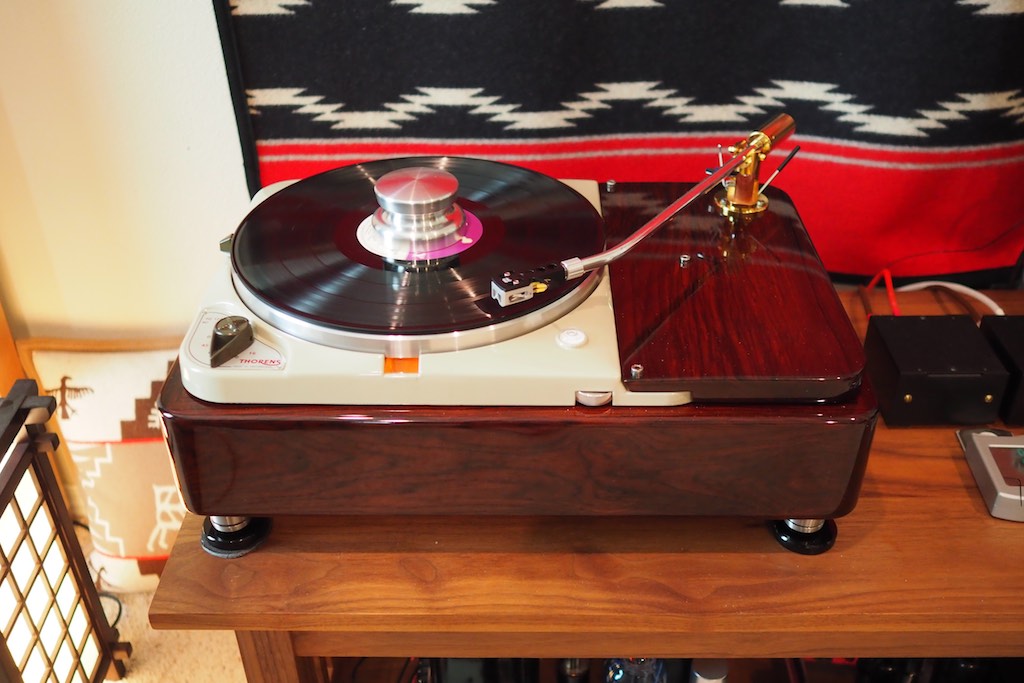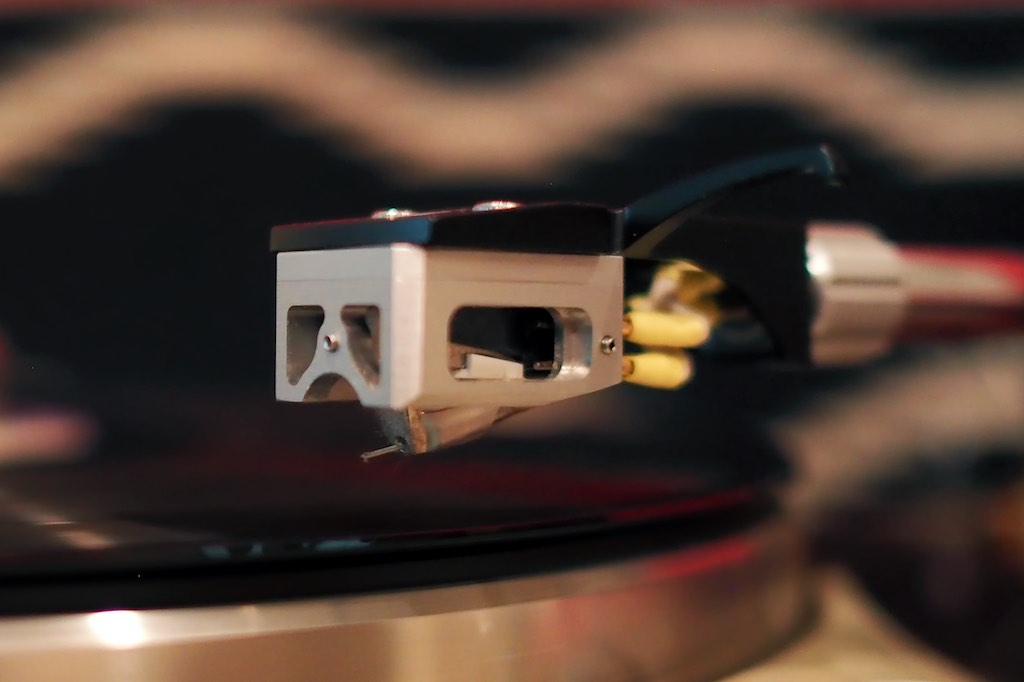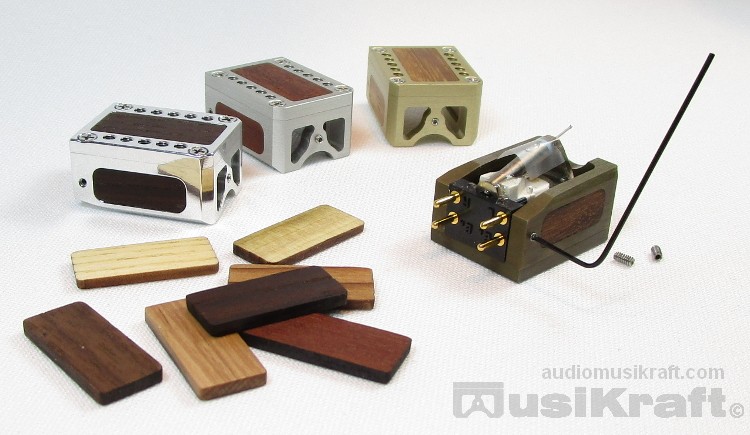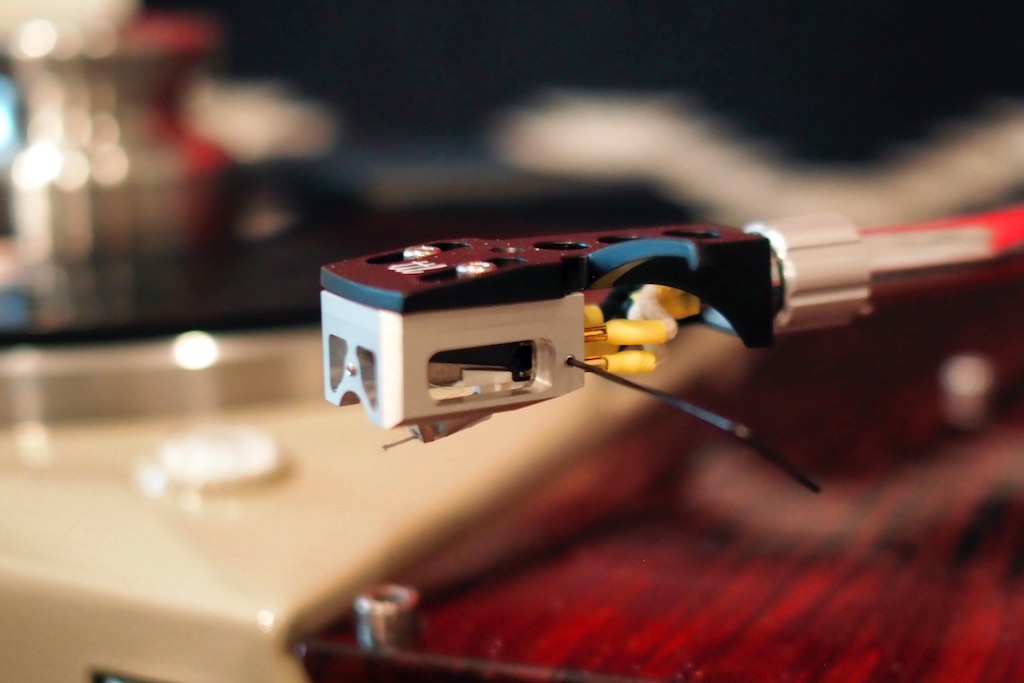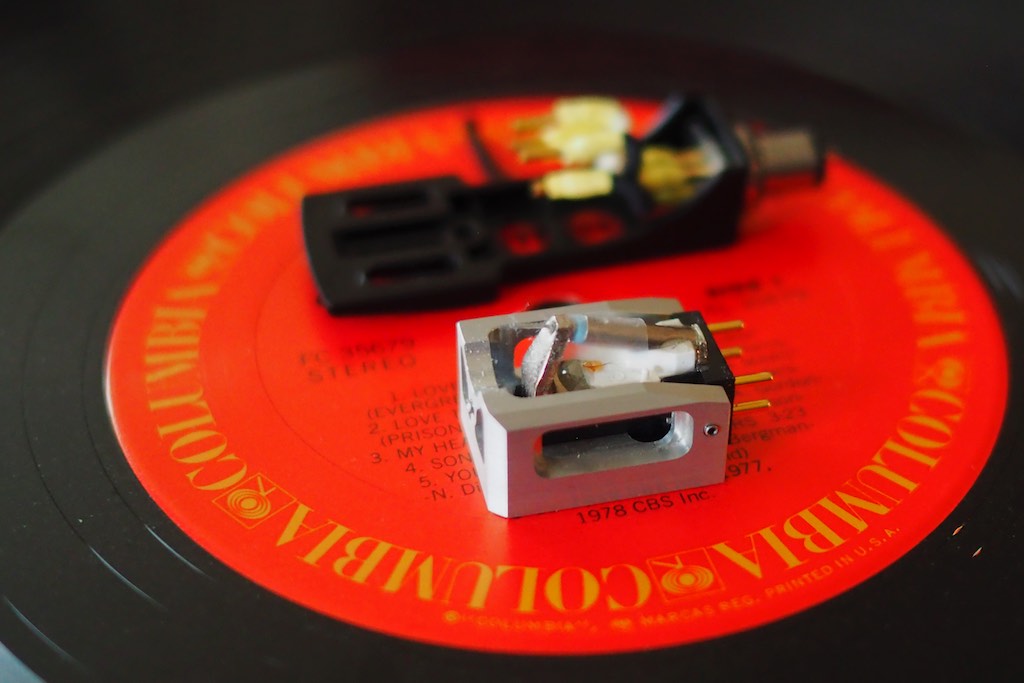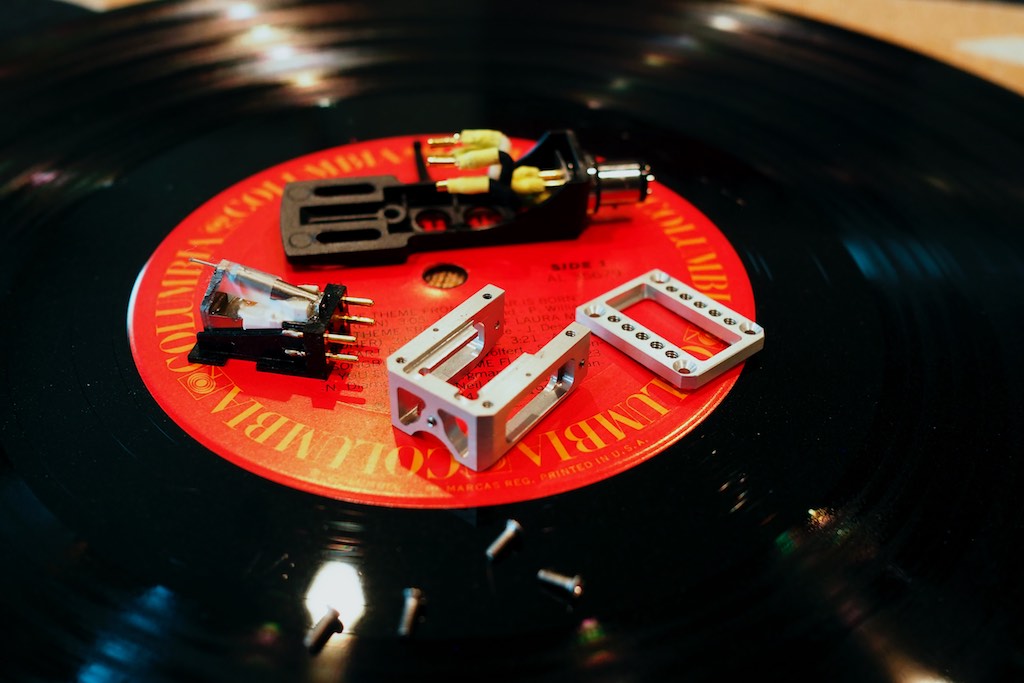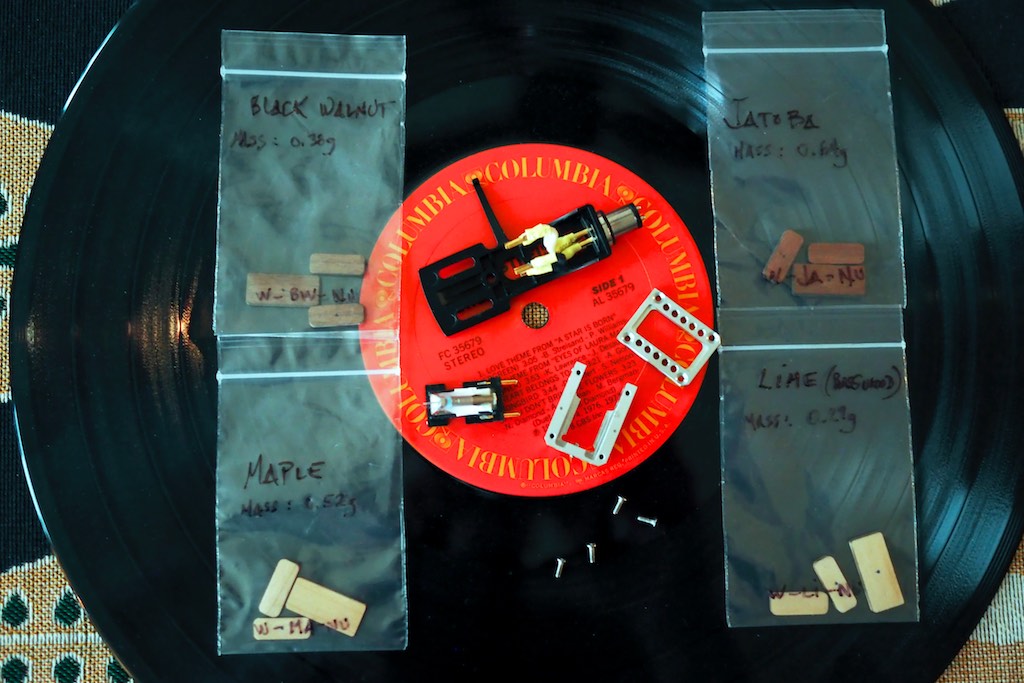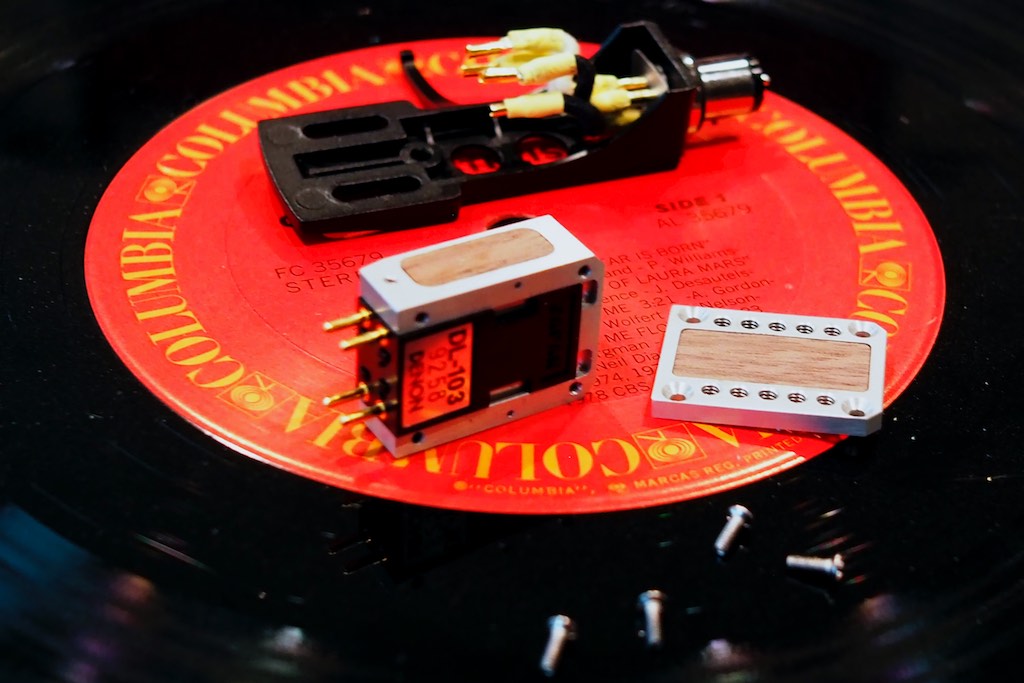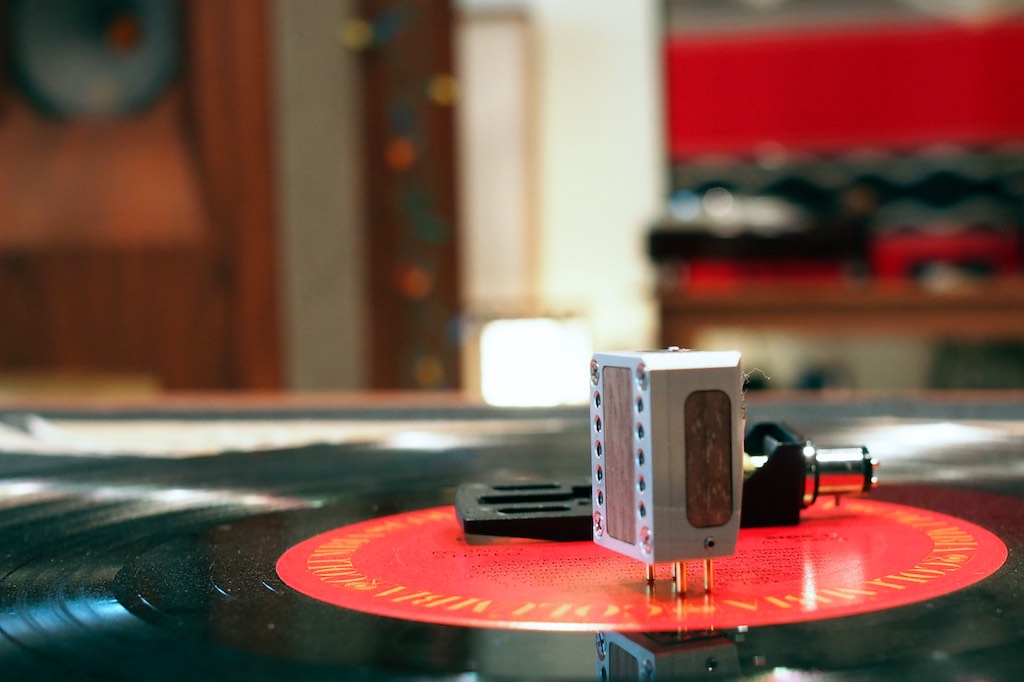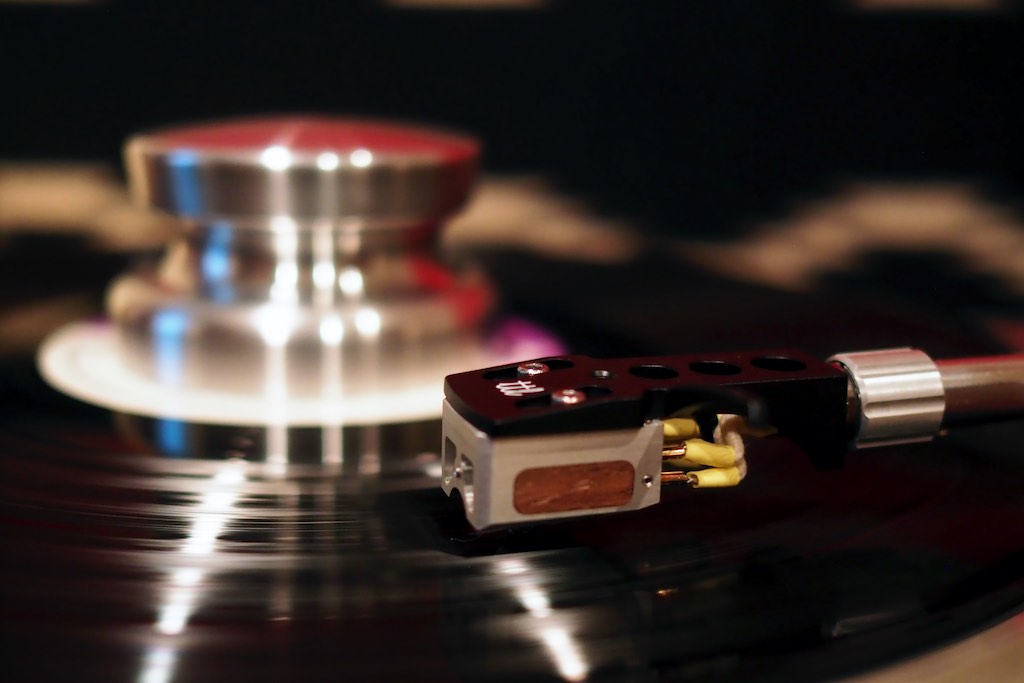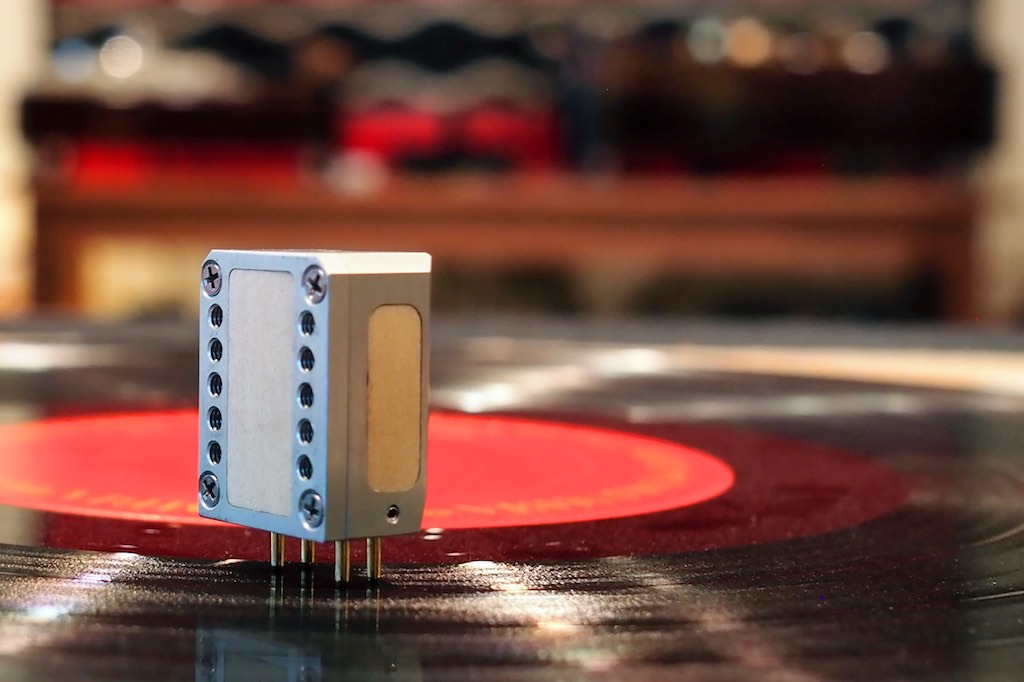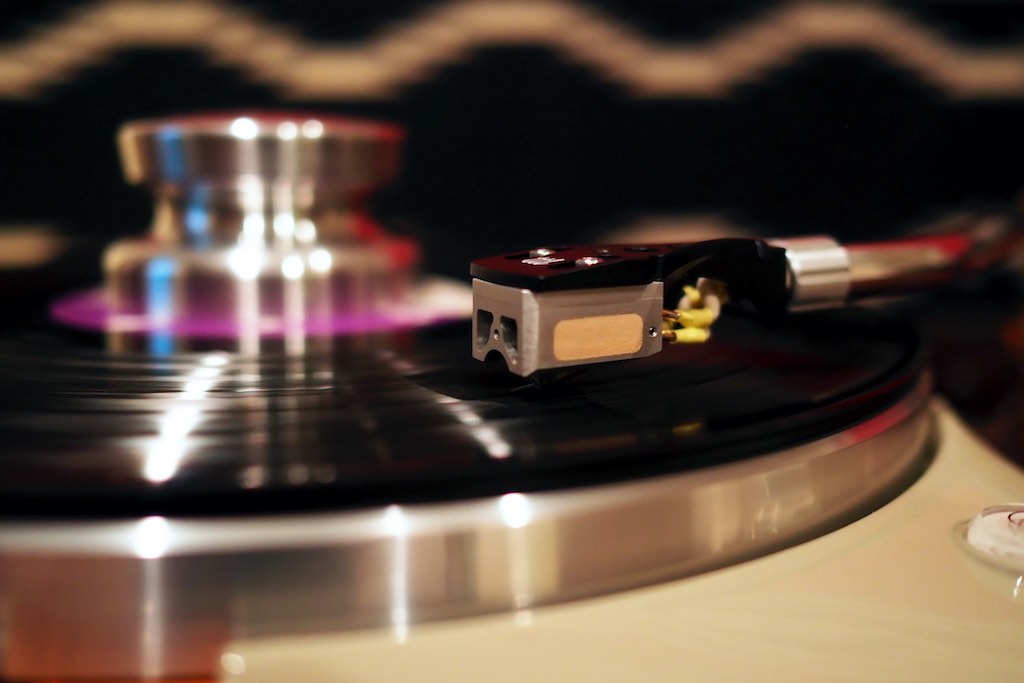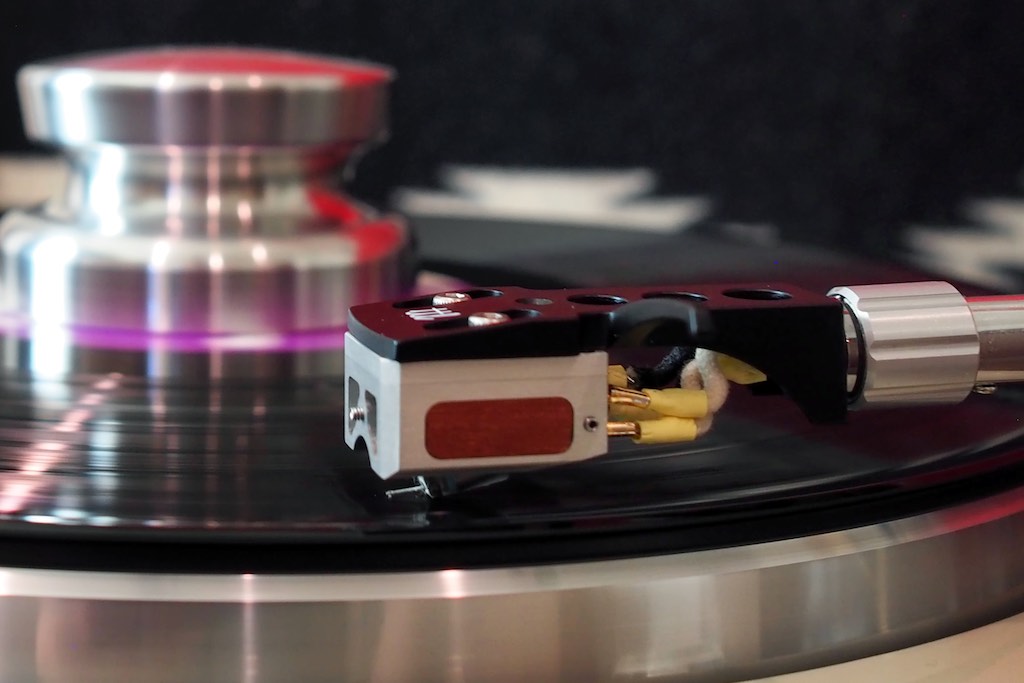It's been a lot of fun exploring the tunable Audio MusiKraft Denon D-103 phonograph cartridge of Guy Pelletier.
Guy sent me the entry level aluminum cartridge shell version ($579 USD) of the Audio MusiKraft Denon DL-103 to try, which has the look & feel of a beautifully crafted precision instrument.
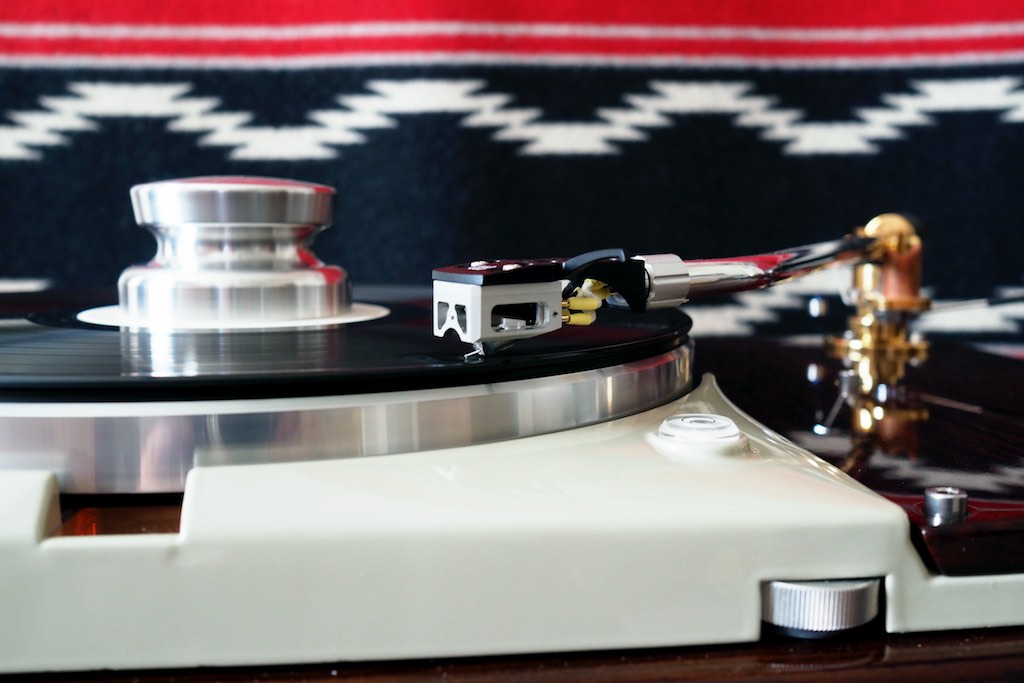
Tunable Audio MusiKraft Denon DL-103.
In my first listen to the Audio MusiKraft Denon DL-103 (above), I compared it to my stock Denon DL-103 (below).
I used identical Audio-Technica AT-HS1 headshells & Art of Tone 22GA headshell leads for the two Denon's, with none of the tunability features in use on the Audio MusiKraft Denon DL-103.
That was so I could get a musical & sonic baseline of how much difference replacing the Denon DL-103's stock plastic cartridge shell with the machined aluminum headshell from Audio MusiKraft made in the Denon's overall performance.
I’ve been mostly listening to the Audio MusiKraft Denon DL-103 on my Artisan Fidelity Thorens TD124 Statement turntable, mounted on my Thomas Schick 12-inch tonearm.
For a step-up transformer, I’m using my Auditorium 23 SUT designed for the Denon DL-103 (below), and I’m using shielded Duelund DCA20GA interconnects from the A23 SUT to my vintage McIntosh MX110Z preamplifier.
I have found the performance of the Audio MusiKraft Denon DL-103 to be extremely satisfying, and it easily outperformed the stock Denon DL-103 musically & sonically in every way.
It’s pretty obvious switching back and forth between the stock Denon DL-103 and the Audio MusiKraft Denon DL-103, that the Audio MusiKraft’s aluminum cartridge shell puts it in a different league from the stock Denon’s plastic cartridge shell.
I’ve enjoyed every minute of my listening with the Audio MusiKraft Denon DL-103, with its tonally colorful, timbrally natural, and vibrant beat and melody performance, and even without considering its tunability features it's an easy recommendation for music lovers and hifi enthusiasts.
I predict that if you enjoy the performance of the stock Denon DL-103 you'll love the performance of the Audio MusiKraft Denon DL-103!
Tunability Features of the Audio MusiKraft Denon DL-103 Phonograph Cartridge
The Audio MusiKraft Denon DL-103 has three primary tunability features:
- There are two adjustable tuning screws on each side of the rear of the aluminum cartridge shell that when engaged apply tension to the Denon DL-103's inner chassis to damp it.
- There is an adjustable tuning screw on the front of the aluminum cartridge shell that when engaged puts tension on the pole piece of the Denon DL-103 to damp it.
- The Audio MusiKraft Denon DL-103 allows for the addition of various species of wood inserts into receptacles located into the top & sides of the aluminum cartridge shell that provide for additional voicing options.
Also, to further your voicing options you can choose between aluminum, aluminum-lithium, and magnesium cartridge shells, each of which offer a somewhat different overall presentation.
A Practical Approach to Learning About the Tunability Features of the Audio MusiKraft Denon DL-103
- Start with the rear tensioning screws.
- First listen to the Audio MusiKraft Denon DL-103 without engaging the rear tensioning screws.
- Then engage the rear tensioning screws so that they lightly contact the inner chassis of the Denon DL-103, and listen to the result.
- Finally, engage the rear tensioning screws with up to a quarter-turn of tensioning past their first contact point, and listen to the result.
- Disengage the rear tensioning screws.
- Then try the front tensioning screw.
- First engage the front tensioning screw so that it's touching the pole piece, but not applying tension, and listen to the result.
- Then engage the front tensioning screw with up to an eighth-turn of tensioning on pole piece, and listen to the result.
- Disengage the front tensioning screw.
- Then try listening to the Audio MusiKraft Denon DL-103 with a set of the wood species tuning inserts installed, and the tensioning screws disengaged:
- One by one, install each set of the different wood species tuning inserts into the top & sides of the cartridge shell, and listen to the results.
- Next try listening to the Audio MusiKraft Denon DL-103 with an oil treated set of wood tuning inserts installed into the cartridge shell.
- First pick one of the sets of the wood tuning inserts, and spread one pass of the supplied oil onto the front side of each piece in the set.
- Wait 1 hour. Then remove the excess oil from the set of wood tuning inserts with a cotton cloth.
- Let the set of wood tuning inserts sit for 4 hours.
- Then spread oil on all of the sides of the set of wood tuning inserts so that they are immersed in oil.
- Let the set of wood tuning inserts sit for one hour, and then remove the excess oil with a cotton cloth. Repeat this oiling step two more times.
- Let sit for 24 hours. Remove any excess oil with a cotton cloth.
- Install the oiled set of wood tuning inserts into the top & sides of the Audio MusiKraft Denon DL-103, and then give it a listen.
- Decide if your preference is for the natural or the oiled set of wood tuning inserts.
- Finally, install your preferred set of wood tuning inserts, and then adjust the rear & front tensioning screws to your preferred setting.
I reported some brief first impressions about the results of using the rear tuning screws in my First Tune post a couple of weeks ago.
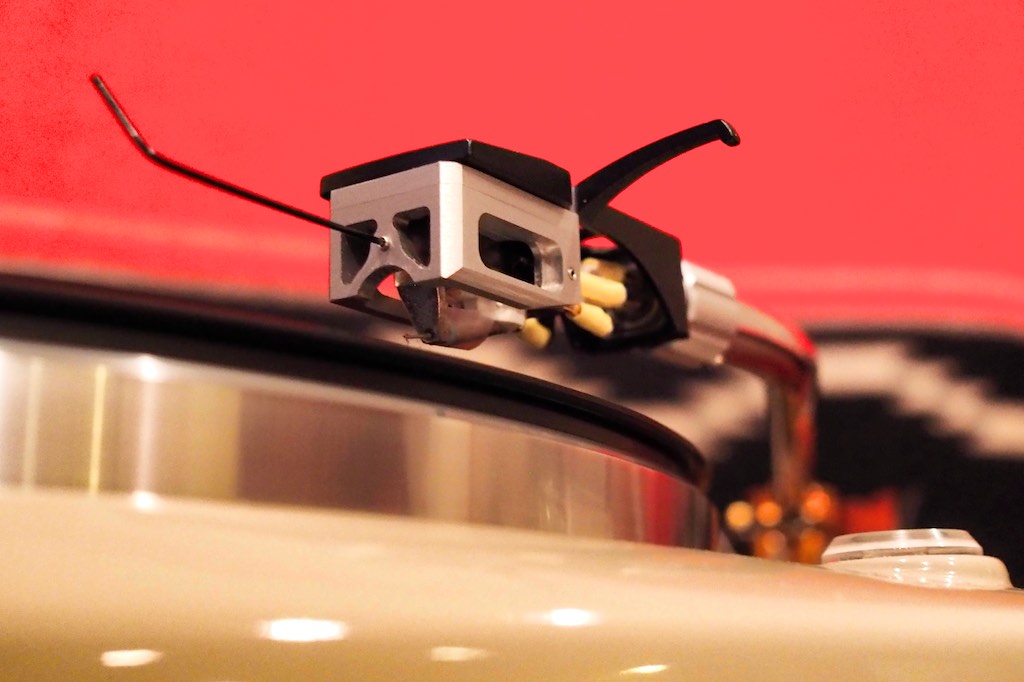
Hex wrench inserted into the front tuning screw that tensions the front pole piece of the Denon DL-103.
Then I followed up shortly after with brief first impressions of the results of using the front tuning screw in my Second Tune post.
In both cases I thought that engaging the tuning screws improved the overall tonality and musicality of the Audio MusiKraft Denon DL-103.
Putting tension on tuning screws emphasized the musical aspects of recordings, like timbre and tone color, for example, which in my system made the music sound more “real” and natural.
With the tuning screws disengaged, recording artifacts had more emphasis (e.g. soundspace), with the Denon sounding more spacious and resonant and giving more of an audiophile-style balance, but at the cost of subtly decreased tonal & timbral nuance, which I thought sounded slightly blurred.
By fine tuning between the two extremes of having the tuning screws engaged or disengaged, you can dial in a favored balance of musicality and sonics.
The magnitude of change I heard from adjusting the tuning screws was not as dramatic as the large improvement realized by replacing the stock plastic Denon cartridge shell with the machined aluminum Audio MusiKraft cartridge shell, but their effects were both easily audible and desirable.
The front tuning screw that tensions the pole piece of the Denon DL-103 provided a larger magnitude of change than the rear tuning screws that apply tension to the inner chassis of the Denon DL-103.
The effects of adjusting both the rear & front tuning screws are easily audible, and I preferred the enhanced musicality that tensioning the screws provided to the overall presentation of the Audio MusiKraft Denon DL-103, but either way, the Audio MusiKraft easily outperforms a stock Denon DL-103, and I find myself quite surprised at the heights that a Denon DL-103 is capable of musically & sonically!
Adjusting the tuning screws was quick & easy, and they are a useful and desirable way to adjust the cartridge’s voicing - a great idea on the part of Audio MusiKraft!
Voicing the Audio MusiKraft Denon DL-103 with Wood Tuning Inserts
Next I wanted to try listening the the Audio MusiKraft Denon DL-103 with the various sets of wood tuning inserts installed.
Voicing the Audio MusiKraft Denon DL-103 by the addition of a set of wood tuning inserts is a bit more daunting than the quick & easy voicing afforded via the tuning screws, which can be done in-situ with the cartridge mounted on the tonearm.
To add or remove sets of wood tuning inserts the cartridge must first be removed from the tonearm and dismounted from the headshell.
Then the Audio MusiKraft machined cartridge shell must be removed from the Denon DL-103 chassis as described in Guy's instructional video above.
Once the Audio MusiKraft Denon DL-103 has been dismantled, sets of wood tuning inserts can be installed or removed as described in Guy's instructional video below.
Before removing the Audio MusiKraft Denon DL-103 from the Schick tonearm on my Thorens TD-124 I refreshed my memory of its performance by listening to a few LPs, then off it came, and I removed it from the Audio-Technica AT-HS1 headshell & Art of Tone 22GA headshell leads.
The next step was to remove the Audio MusiKraft machined aluminum cartridge shell from the Denon DL-103.
Even though I was filled with a bit of trepidation at dismantling the Audio MusiKraft Denon DL-103, it turned out to be a breeze.
First I loosened all the tuning screws to make sure they weren't in contact, I then removed the 4 hex screws that secure the top of the cartridge shell to its body.
The Denon DL-103 then slid right out, easy as can be.
I had asked Guy to send me sets of wood tuning inserts that covered a wide spectrum of voicing possibilities.
Guy sent me four sets of wood tuning inserts to try:
- Lime: Mass = 0.29g
- Black Walnut: Mass = 0.38g
- Maple: Mass = 0.52g
- Jatoba: Mass = 0.64g
I decided I'd give the Black Walnut a try first. I was able to insert the top and side pieces of Black Walnut into the cartridge shell receptacles quite easily with light finger pressure.
I put the Audio MusiKraft cartridge back together, mounted it back into the headshell, and installed it back onto the Schick tonearm.
Because the of the extra mass of the Black Walnut wood inserts, it was necessary to reset the tracking force to approximately 2.5 grams.
Then I put on the The Alternate Blues, which I had been listening to just prior, and gave it a listen with the set of Black Walnut tuning inserts installed into the Audio MusiKraft Denon DL-103.
I'm not sure what I was expecting to hear with the Black Walnut wood tuning inserts installed (tuning screws not engaged), but I wasn't really prepared for the large difference in sound I heard on The Alternate Blues.
The first thing I noticed was how much more "in the room" presence the instruments had, the improved bass note definition, how the overall resolution had improved, and how the music sounded more "live".
I pretty much liked everything I was hearing, with one exception - the muted trumpet now sounded way too brash and forward for my tastes.
The muted trumpet tonality took my by surprise, as I thought if anything the Black Walnut tuning inserts would mellow out the muted trumpet a bit on The Alternate Blues, so the added forwardness was just the opposite of what I was expecting, and I didn't care for it.
I added an eighth-turn of tension to the front tuning screw to see if that would reign in the muted trumpet a bit, and it did, a bit, taking away some of the add forwardness, but it also diminished the overall sense of presence and articulation somewhat.
Then I dialed in a quarter-turn of tension on the rear tuning screws, which helped reign in the muted trumpet a little bit more, which was more to my liking, but still I thought the muted trumpet tonality was too brash and forward.
So my first experiment with the Black Walnut set of tuning inserts (mass = 0.38g) didn't fare so well overall, and I preferred the performance of the Audio MusiKraft cartridge without the set of Black Walnut tuning inserts installed.
I dismounted the Audio MusiKraft Denon DL-103 from the tonearm, disassembled it, removed the Black Walnut set of tuning inserts from the cartridge shell, installed the Lime set of of tuning inserts in their place, reassembled the Audio MusiKraft Denon DL-103, mounted it back on the Schick tonearm, and reset the tracking force to 2.5 grams.
The Lime set of tuning inserts were a closer match to my tastes, having similar good qualities of the Black Walnut set of tuning inserts in terms improved presence, better bass line delineation, improved overall resolution, albeit all to a slightly lesser degree than with the Black Walnut.
What I didn't like about the Black Walnut set of tuning inserts was that on The Alternate Blues the muted trumpet sounded way too brash and forward.
However, with the Lime set of tuning inserts the muted trumpet was moderated somewhat and was more pleasing and natural sounding, but still a touch too forward and brash.
I then engaged the front & rear tuning screws so they were just touching the pole piece & inner chassis, respectively, and I heard a slight improvement in overall muted trumpet tonality.
I then tensioned the front & rear tuning screws an eighth-turn & quarter turn, respectively, and again gained some additional improvement in muted trumpet tonality.
I should mention that much of the enhanced presence of the Lime set of tuning inserts remained upon tensioning the tuning screws, bass lines became a little more prominent, but overall resolution dropped a little bit.
Overall, I liked the presentation with the Lime set of tuning inserts installed, although I'm not yet sure that I prefer the presentation to the Audio MusiKraft Denon DL-103 with no tuning inserts installed, so I'll have to do some more listening to sort that out.
Again I dismounted the Audio MusiKraft Denon DL-103 from the tonearm, disassembled it, removed the Lime set of tuning inserts from the cartridge shell, installed the Jatoba set of of tuning inserts in their place, reassembled the Audio MusiKraft Denon DL-103, mounted it back on the Schick tonearm, and reset the tracking force to 2.5 grams.
The Lime set of tuning inserts have a mass of 0.29g and are the lightest of the four sets of tuning inserts that Guy sent me.
The Jatoba set of tuning inserts have a mass of 0.64g and are the heaviest set of the four sets of tuning inserts that Guy sent me, more than twice as heavy as the set of Lime tuning inserts.
I was expecting the wood tuning inserts to follow a mass relationship with respect to trends in musicality & sonics, but that doesn't appear to be the case, so there must be more to their tuning effects than just mass.
For example, the lightest of the wood tuning insert sets are the Lime (0.29g), which I significantly preferred to the heavier Black Walnut (0.38g).
But my mass theory was dashed when the heaviest Jatoba set of inserts (0.64g) provided the best muted trumpet tonality of the three sets of wood tuning inserts I've tried so far.
The Jatoba set of tuning inserts also displayed improved presence, better bass line delineation, improved overall resolution, which fell somewhere in between the Lime and Black Walnut for those traits, and an overall richer and more spacious sound.
The muted trumpet in The Alternate Blues were very nearly in the acceptable range for tonality with the Jatoba set of tuning inserts, with almost all of the unnatural forwardness gone.
I then engaged the front & rear tuning screws so they were just touching the pole piece & inner chassis, respectively, and I heard a slight improvement in overall muted trumpet tonality, and definitely an improvement over the set of Lime tuning inserts for the same amount of engagement of the tuning screws.
I followed that by tensioning the front & rear tuning screws an eighth-turn & quarter turn, respectively, and gained some additional improvement in muted trumpet tonality.
The combination of the Jatoba tuning inserts, plus the tensioning of the front & rear tuning screws, provided the best results so far for the three types of wood tuning inserts.
The final set of wood tuning inserts that I have to try are Maple, which are the second heaviest of the four sets at 0.52g.
The Maple tuning inserts intrigued me because maple is one of the more common tonewoods used in guitars, along with Mahogany and Rosewood.
For example, my Eastman archtop jazz guitar has a maple back & sides (and a Spruce top), my Gibson Advanced Jumbo has rosewood back & sides, as does my Collings OM short-scale cutaway (both with Spruce tops), and my Waterloo WL-14 L has mahogany back & sides (and a Spruce top).
So, same drill: I dismounted the Audio MusiKraft Denon DL-103 from the tonearm, disassembled it, removed the Jatoba set of tuning inserts from the cartridge shell, installed the Maple set of of tuning inserts in their place, reassembled the Audio MusiKraft Denon DL-103, mounted it back on the Schick tonearm, and reset the tracking force to 2.5 grams.
The drill of replacing the wood tuning inserts might seem a little daunting at first, but after a couple of tries it becomes quick & easy, so no need to worry on that front.
The Maple set of tuning inserts was the first of the four sets that I thought portrayed the tonality of muted trumpet realistically in my system, and even without engaging and/or tensioning the tuning screws it sounded right on.
I guess there's a reason Maple is referred to as a tonewood, as it uniformly has great tone across all the instruments in The Alternate Blues, giving a beautifully realistic horn tone, bass tone, guitar tone, drums, and piano.
Also in evidence was a very natural and expansive sense of recorded space, lots of presence, nuance, and music being presented as an organic, interactive, evolving expression of art.
If you would like to learn more about the sound qualities of tonewoods used in guitars, there is a nice tonewood primer on the Acoustic Guitar magazine website here.
Consider these to be very preliminary general impressions, as I'm still working through the learning process of utilizing the tunability features of the Audio MusiKraft Denon DL-103.
Later on I'll go into a more detailed analysis of the sonic aspects of the recording process like imaging, soundstage, resolution, and soundspace, as well as the musical attributes of tone color, timbre, dynamics, melody, harmony, and beat.
Next time I'll explore oiling a set of the wood tuning inserts and see how that effects the sonics & musicality of the Audio MusiKraft Denon DL-103 phonograph cartridge.
As always, thanks for stopping by, and may the tone be with you!




